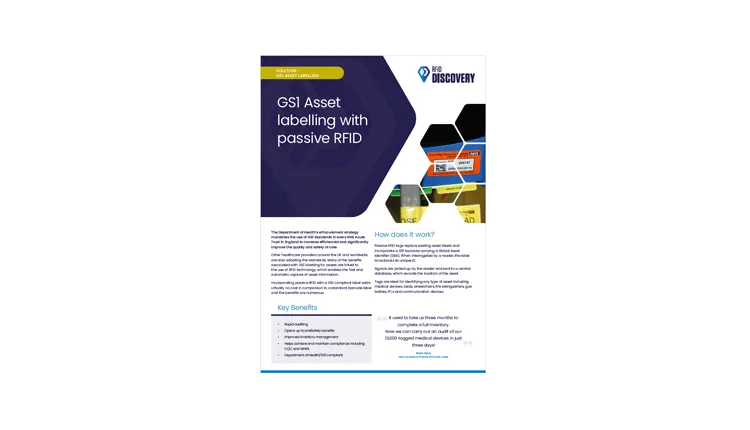GS1 compliant labels

Benefits
Using RFID technology has improved our care and provided a phenomenal return on investment by saving us hundreds of thousands of pounds and thousands of hours of nurses' time.
The Department of Health mandates the use of GS1 standards in every NHS Acute Trust in England
The RFiD Discovery GS1 Asset Labelling solution supports the Scan4Safety initiative which helps the NHS save thousands of lives and millions of pounds. The Department of Health's eProcurement strategy mandates the use of GS1 standards in every NHS Acute Trust in England - to increase efficiencies and significantly improve the quality and safety of care.
When used in conjunction with RFID tags, GS1 numbers and barcodes provide the necessary information and process controls to manage devices more effectively. Linking device barcodes to barcoded patient wristbands supports the NHS Scan4Safety initiative by making it easy to record which medical equipment has been used on which patients.
How GS1 Asset Labelling with passive RFID works?

Passive RFID labels
Passive RFID labels replace the existing asset labels, and are fully compliant with GS1 standards, carrying a Global Individual Asset Identifier (GIAI). They are encoded with a unique ID which is linked to a particular asset in the database on registration.
The reading process
Different types of passive RFID readers are used to capture data from the tags and send location information to a central database. A specially designed trolley fitted with a UHF RFID reader performs equipment searches as it is pushed around the hospital. A mobile handheld reader is used to audit wards or locate specific equipment and fixed readers can be mounted in key areas with a high number of equipment moves.
Scan4Safety
When a medical device is used on a patient, the GS1 compliant asset label is scanned as well as the patient's wristband. Using GS1 numbers to identify all medical devices as well as locations, staff, patients and products, provides Trusts with reliable information about who did what to whom – when, where and why.




